The following figures are shown by the leaflet of the War Remnants Museum
in Ho Chi Minh which I received on my trip.
It reveals the bare truth that US army committed atrocities during the
Vietnam War.
I was very surprised to read the history book that Gulf of Tonkin Incident
might have been a fictional attack, so-called a pretext of opening war.
Because this incident caused President Johnson for deeper into the quagmire
known as the Vietnam War.
Meanwhile dictators of the world must do like this, or more than US did.
Now since US is active in disclosing information, we can see such things.
Information disclosure doesn't justify American act in Vietnam at all,
but some of them surely try to learn something from the war.
We don't sit it on the sidelines, and must learn from history as well as
them.
We must not tolerate such a disaster happening again by seeing human's
foolishness who the war began, and many kind of uncommon acts by people
in extreme situations.
But history foolishly repeats itself.
Many wars are caused by the pursuit of wealth and desire of person of power.
And resistance to him/her...
Now pitiful victims must be arisen anywhere on the planet by a disaster
happening.
I thank for being born in peaceful Japan.
By the way, do Iraq War (Operation Iraqi Freedom) and Vietnam War have something in common?
Therefore The Fictional Times (maybe a kind of tabloid) said "Bush Proposes Congressional War Resolution - Wording Drawn From 1964 Gulf of Tonkin Resolution."
I think the fact, how about you?
| Robert S. McNamara (former Secretary of Defense under Presidents Kennedy
and Johnson) - IN RETROSPECT - The Tragedy and Lessons of Vietnam Preface XVI - Times Books, NY, April 1995. |
"Yet we were wrong, terribly wrong. We owe it to future generations to explain why." The following figures represent a part of those terrible wrong doings. In the Vietnam war, the US Government mobilized 6.5 million young people who took turns in fighting. The total US Force reached 543,400 men engaged, including 70% from the Army, 60% from the Air Force, 60% from the Marines and 40% from the Navy. 22,000 US plants and factories supplied the war with their products.7,850,000 tons of bombs of all kinds were dropped over Vietnam plus 75,000,000 liters of defoliants - including dioxin-were sprayed over croplands, farmlands, forestlands and villages in the Southern part of this country. In World War Two, the US had dropped 2,057,244 tons of bombs over different battlefields. According to the figures made public by the US government, 352 billion dollars were spent for the Vietnam war. In North Vietnam bombs and bullets destroyed or heavily damaged 2,923 school buildings - from primary schools to colleges - 1,850 hospitals, wards, nurseries, 484 churches and 465 temples and pagodas. Nearly 3 million Vietnamese were killed, and 4 million others injured, according to incomplete figures. Over 58,000 American armymen died in the war. Yet long-term consequences have not been completely determined in the Vietnam war. In retrospect, it is not for inciting hatred, but just for learning lessons from history: human beings will not tolerate such a disaster happening again, neither in Vietnam nor anywhere on the planet. |
| photographic library | |
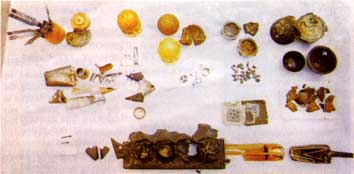 Some kinds of mass killing bombs, among them, the "Frag bomb" was widely used in Vietnam. |
 A victim of "Frag " bombs |
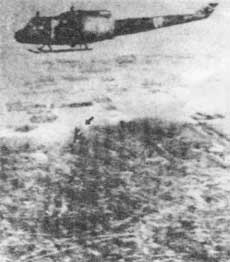 Refusing to answer interrogations, a man was being thrown from a flying helicopter. |
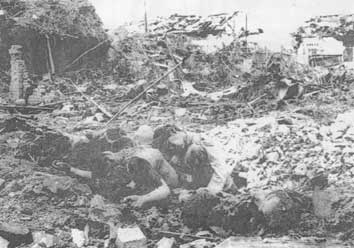 A hospital in the suburbs of Hai Phong city attacked by B.52s during the night of April 16, 1972. |
 To attack any village, American Infantry troops came to surround it, while jet bombers dropped bombs violently, shooting at random, and finally armed helicopters spat rockets, using machine-guns to fire everywhere. In 1966, Cavalry Division 1, in Binh Dinh. (Bunyo Ishikawa - The war for the liberation of Vietnam) |
 United Press International photographer Kyoichi Sawada top prize for news photography at the 10th annual World Press Photo Exhibition here. This is the photo, called "Dusty Death" that took the prize. It shows the body of a Viet Cong soldier, killed in a night fight with U.S. and Australian Forces, being dragged behind and armored carrier near Tan Binh, South Vietnam. (February 24, 1966) |
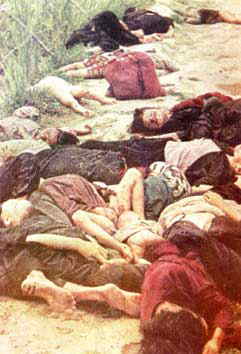 On March 16, 1968 a mass massacre took place in Son My (My Lai) village, Son Tinh district, Quang Ngai province. 504 people were killed. |
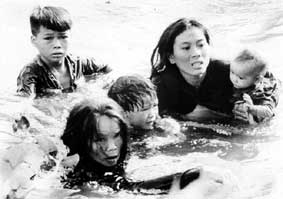 [QUI NHON, South Vietnam] A Vietnamese mother and her children wade across a river to escape U.S aircraft bombs during a strike on their village near here, recently 9/8/1965. The air raid attempted to knock out Viet Cong snipers who were firing on U.S. Marines from the village. Women and Children were removed from the hamlet before the attack began. (Photo by Kyoichi Sawada) |
Related Sites
[Back to the travelogue of Vietnam and Cambodia]
[Back to the page of tourist attractions in Ho Chi Minh (Saigon)]